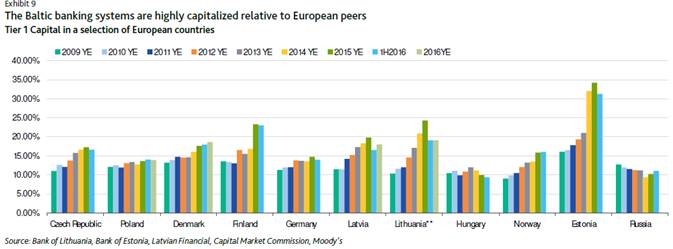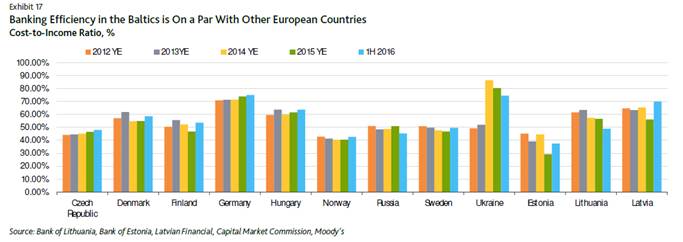Analytics, Banks, Direct Speech, EU – Baltic States, Financial Services
International Internet Magazine. Baltic States news & analytics
Thursday, 25.12.2025, 22:14
Better Asset Quality and Lower Share of NonResident Deposits Drives Positive Outlook for Baltic Countries
 Print version
Print version |
|---|
Operating Environment.
A rebound in exports to other European countries, combined with accommodative
monetary conditions, will support corporate investment, job creation and
household consumption, causing real GDP to expand in all three Baltic countries
over the next two years. We forecast GDP growth of 2.5% and 2.9% in 2017 and
2018 respectively in Estonia (A1 stable), 3.1% and 3.9% in Latvia (A3 stable),
and 3.3% and 3.5% in Lithuania (A3 stable). We expect lending to grow between
5% and 10% annually. Downside risks remain from continued tensions with Russia.
Asset quality and
capital. We expect asset quality to improve in Latvia and Lithuania as
higher employment levels and higher real wages will continue to support
recoveries in legacy loans. Asset risk will remain stable in Estonia, with
problem loan ratios already on par with the low levels found in the Nordic
countries. Additionally, local banks will maintain or improve their already
solid capital metrics despite the relatively strong growth of their balance
sheets, as increases in minimum regulatory requirements and solid internal
capital generation will support capital retention. In contrast, we expect the
subsidiaries and branches of Nordic banks operating in the Baltics to upstream
capital to their parents, while nevertheless remaining well capitalized.
Funding and liquidity.
Baltic banks will continue to strengthen their funding and liquidity profiles
through a substantial reduction in volatile non-resident deposits, which will
be offset by strong growth in domestic deposits. The decline in non-resident
deposits will also lead to a reduction in the equally volatile short-term
liquid assets they tended to acquire with those foreign deposits. Meanwhile, we
expect Nordic banking operations in the Baltics to slightly reduce their reliance
on parental funding. Profitability and efficiency. Overall, the favourable
macroeconomic environment will lead to stable profitability in the system, with
potential opportunities for domestic banks to increase both market shares and
profits as the merger between the subsidiaries
Government support. Baltic banks are
subject to the EU's Bank Recovery and Resolution Directive (BRRD), a resolution
regime under which losses are primarily borne by equity and debt holders. The
institutions we rate do not benefit from government support uplift.4










 «The Baltic Course» Is Sold and Stays in Business!
«The Baltic Course» Is Sold and Stays in Business!

